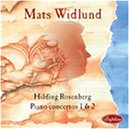| All Artists: Hilding Rosenberg, Petter Sundkvist, Swedish Radio Symphony Orchestra, Mats Widlund Title: Hilding Rosenberg: Piano Concertos 1 & 2 Members Wishing: 0 Total Copies: 0 Label: Daphne Records Release Date: 3/23/1999 Genre: Classical Styles: Chamber Music, Forms & Genres, Concertos, Historical Periods, Classical (c.1770-1830) Number of Discs: 1 SwapaCD Credits: 1 UPCs: 034061400622, 7330709010066, 733070901004 |
Search - Hilding Rosenberg, Petter Sundkvist, Swedish Radio Symphony Orchestra :: Hilding Rosenberg: Piano Concertos 1 & 2
 | Hilding Rosenberg, Petter Sundkvist, Swedish Radio Symphony Orchestra Hilding Rosenberg: Piano Concertos 1 & 2 Genre: Classical
|
Larger Image |
CD Details |
CD ReviewsRosenberg's Symphonic Concertos Thomas F. Bertonneau | Oswego, NY United States | 11/06/2000 (5 out of 5 stars) "Hilding Rosenberg (1892-1985) always thought big. His Fourth and Fifth Symphonies (1944 and 48), for example, require vocal soli and choruses in addition to a large orchestra. Rosenberg's two piano concertos (1930 and 1950) do not except themselves from the rule: Both amount to symphonies with an important - and terrifically difficult - concertante role for the keyboard. The First Concerto comes with a story: Rosenberg (the terminal "rg" in Swedish is the equivalent of a trilled "r" in English) wrote it on a request in 1930 but felt misgivings about the score and never completed it beyond the Second Movement; it then lay in his files, forgotten, and did not become public until after his death. From the first bars, cognoscenti will recognize the expressionist ethos of "Sinfonia Grave" (No. 2) and the pre-war decade. Despite its lacking the projected Third Movement, the First Concerto clocks in at twenty-five minutes, and it seems complete enough. The First Movement (Allegro), bursting at the seams with energy, is reminiscent of the Prokofiev of the Second and Third Symphonies, although not so dissonant. Sometimes the keyboard part sounds percussive, as in the Bartók concertos; sometimes it pursues an improvistaory melodic line with only spare accompaniment. The colossal Second Movement (Adagio) takes up fifteen of the overall twenty-five minutes demanded by the score. The Second Piano Concerto, written twenty years after the First, operates on a similarly large scale, this time incorporating the Third Movement that eluded the composer the first time around. Again, explosive energy animates the toccata-like First Movement (Allegro), set off by a pounding rhythm in the tympany, taken up by the keyboard, and then transferred to the orchestra after a meditative excursion (keyboard and strings, divisi). The Second Movement (Andante) begins with a canon in the strings, followed by woodwind figurations, which in turn lead into the keyboardist's exposition in a distinctly meditative mood. The music is "tranquil," as the marking indicates. The Third Movement (Allegro) returns to the moto-perpetuo character of the First Movement, and deals in simple-sounding motifs that the composer works up into a rhythmic frenzy. (Rosenberg the humorist, also heard in the ballet "Orpheus in Town," is much to the fore here,) The soloist in these recordings is Mats Widlund, whose control is remarkable, and whose ability to bring out the variations in mood contributes much to the convincing realization of both scores. Petter Sundkvist leads the Swedish Radio Symphony Orchestra, an ensemble often led by Rosenberg himself during his long career as the central figure in Swedish music."
|

 Track Listings (5) - Disc #1
Track Listings (5) - Disc #1